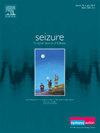Neuromodulation with Transcranial Magnetic Stimulation in Epilepsia Partialis Continua: Scoping review and clinical experience
IF 2.7
3区 医学
Q2 CLINICAL NEUROLOGY
引用次数: 0
Abstract
Introduction
Epilepsia Partialis Continua (EPC) is a challenging condition in which repetitive transcranial magnetic stimulation (rTMS) can induce a neuromodulation effect of potential diagnostic and therapeutic value.
Methods
A comprehensive literature search was conducted using Pubmed and Web of Science databases to identify cases of EPC who underwent rTMS, including children and adults. Additionally, we present two patients from our centre who underwent rTMS at a low frequency (0.5 Hz) with simultaneous EEG recording with the aim of assessing potential improvement in seizure frequency and severity.
Results
Eight articles were selected comprising 16 patients (15 with EPC and one with continuous myoclonia). In three of these patients, no clinical or EEG changes were noted; the remaining cases showed transitory clinical improvements. We report two patients with EPC, in whom low frequency rTMS was associated with transient reduction in frequency and severity of seizures and improvements in hand function and dexterity. In one of these cases, rTMS suggested a potential target for intracranial recordings, subacute cortical stimulation and localised resection.
Conclusion
In selected patients with EPC, rTMS can be used as a potential diagnostic and therapeutic tool.
经颅磁刺激治疗癫痫持续状态:范围综述和临床经验。
简介:癫痫持续状态(Epilepsia Partialis Continua,EPC)是一种具有挑战性的疾病,重复经颅磁刺激(rTMS)可诱发神经调控效应,具有潜在的诊断和治疗价值:我们使用 Pubmed 和 Web of Science 数据库进行了全面的文献检索,以确定接受经颅磁刺激治疗的 EPC 病例,包括儿童和成人。此外,我们还介绍了本中心的两名患者,他们接受了低频(0.5赫兹)经颅磁刺激,同时进行了脑电图记录,目的是评估癫痫发作频率和严重程度的潜在改善情况:结果:共选取了8篇文章,包括16名患者(15名EPC患者和1名持续肌张力障碍患者)。其中三例患者未发现临床或脑电图变化,其余病例临床症状有短暂改善。我们报告了两名 EPC 患者,低频经颅磁刺激可短暂降低癫痫发作的频率和严重程度,改善手部功能和灵活性。在其中一个病例中,经颅磁刺激提示了颅内记录、亚急性皮质刺激和局部切除的潜在目标:结论:经颅磁刺激可作为一种潜在的诊断和治疗工具,用于选定的EPC患者。
本文章由计算机程序翻译,如有差异,请以英文原文为准。
求助全文
约1分钟内获得全文
求助全文
来源期刊

Seizure-European Journal of Epilepsy
医学-临床神经学
CiteScore
5.60
自引率
6.70%
发文量
231
审稿时长
34 days
期刊介绍:
Seizure - European Journal of Epilepsy is an international journal owned by Epilepsy Action (the largest member led epilepsy organisation in the UK). It provides a forum for papers on all topics related to epilepsy and seizure disorders.
 求助内容:
求助内容: 应助结果提醒方式:
应助结果提醒方式:


